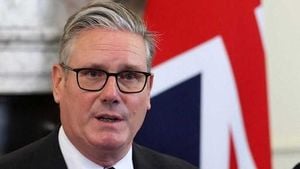India is on the verge of rolling out one of the most extensive infrastructure programs of the 21st century, according to a recent report from KPMG. This ambitious initiative is seen as pivotal for the nation’s continued status as the world’s fastest-growing major economy, driven largely by substantial government spending on large-scale projects across key sectors like highways, seaports, airports, and railways. To bolster this endeavor, experts stress the importance of creating fiscal strategies to attract both domestic and foreign investment.
The ‘KPMG 2024 Infrastructure and Transport CEO Outlook’ report highlighted the optimism among CEOs within the infrastructure sector, where 63% anticipate earnings growth exceeding 2.5% over the next three years. Despite the positive outlook, these industry leaders voiced concerns about challenges such as technology adoption, talent competition, and the imperatives of environmental stewardship. Interestingly, they noted how quickly stakeholder expectations around Environment, Social, and Governance (ESG) matters are changing, potentially outpacing their current strategies.
Meanwhile, it’s clear from the data presented by KPMG, gathered from 120 industry executives globally, there’s heightened awareness of the risks associated with advancements like generative AI and the looming threat of climate change on both immediate and future growth prospects.
“The CEOs expressed valid concerns surrounding talent shortages and the intricacies of the technological environment. Nevertheless, they are expressing noteworthy ambition, committing to investment in AI capabilities and focusing on workforce development,” stated Manish Aggarwal, KPMG’s partner and head of Infrastructure and Special Situations Group.
Besides infrastructure developments, India’s equity markets have been shining brightly on the global stage, outpacing China’s stock market since the turn of the millennium. A recent Deutsche Bank report highlighted how Indian equity markets recorded average annual returns of +6.9% since 2000, compared to +4% for China. Investors have shown growing confidence, with the Indian market being valued highly alongside the U.S. market, chiefly due to expectations of significant growth potential driven by advancements in technology and innovation.
“The outlook for both India and the U.S. remains largely positive, though valuations have reached overinflated levels compared to traditional metrics. This poses potential risks, yet the structural growth opportunity appears to be attracting savvy investors,” said analysts when discussing these trends.
Prime Minister Narendra Modi recently elaborated on his vision for India to achieve developed nation status by 2047 during his address at the Hindustan Times Leadership Summit. His speech emphasized restoring public trust and delivering on promises made by the government. “We have brought trust back to governance through integrity and commitment to progress,” he remarked, outlining the contributions made by his administration to empower ordinary citizens.
Modi’s agenda focuses on investments leading to job creation and improvements in quality of life for Indian citizens. He underscored the government’s commitment to infrastructural development, which includes substantial capital investments—up from ₹16 lakh crore to ₹48 lakh crore since 2014. He proudly cited achievements such as the construction of toilets to promote dignity, the expansion of access to clean cooking fuel, and the proliferation of digital payment systems, all intended to uplift socio-economic standards.
The Prime Minister also acknowledged the rise of over 125,000 startups across the nation, portraying them as emblematic of the newly instilled confidence among citizens to partake boldly in enterprise. Citing personal stories of everyday risks taken, he illustrated how the government’s efforts to build infrastructure have empowered citizens to engage actively and innovatively.
Further emphasizing the government’s achievements, Modi noted the substantial savings generated through programs like Ayushman Bharat, which has provided cost-effective healthcare, and the Ujala initiative to lower electricity bills. These efforts aim to translate growing economic prosperity and infrastructural confidence back to the common citizen.
Notably, the establishment of the GIFT International Fintech Institute aims to position India as a global frontrunner within the burgeoning fintech industry. Launching officially in January 2025, GIFT IFI is a collaboration of prominent educational institutions including Gujarat International Finance Tec-City, Ahmedabad University, IIT Gandhinagar, and UC San Diego. The Institute seeks to develop specialized talent capable of thriving amid the sector's rapid transformations.
According to Professor Pankaj Chandra of Ahmedabad University, this initiative will be pivotal for nurturing mastery within fintech. He remarked, “This collaborative approach presents us with the opportunity to address real-world challenges and deliver substantial advancements to the industry.” This innovative educational model will empower professionals from diverse backgrounds to continuously evolve alongside technological advancements.
Overall, India stands at a crossroads with its ambitious infrastructural plans, blossoming equity markets, and educational initiatives aligned with future-focused industries. The collective momentum across various sectors and the government’s clear vision for enhancing public welfare could be the launchpad needed for sustaining its economic growth and fulfilling the ambitions of its citizens.



